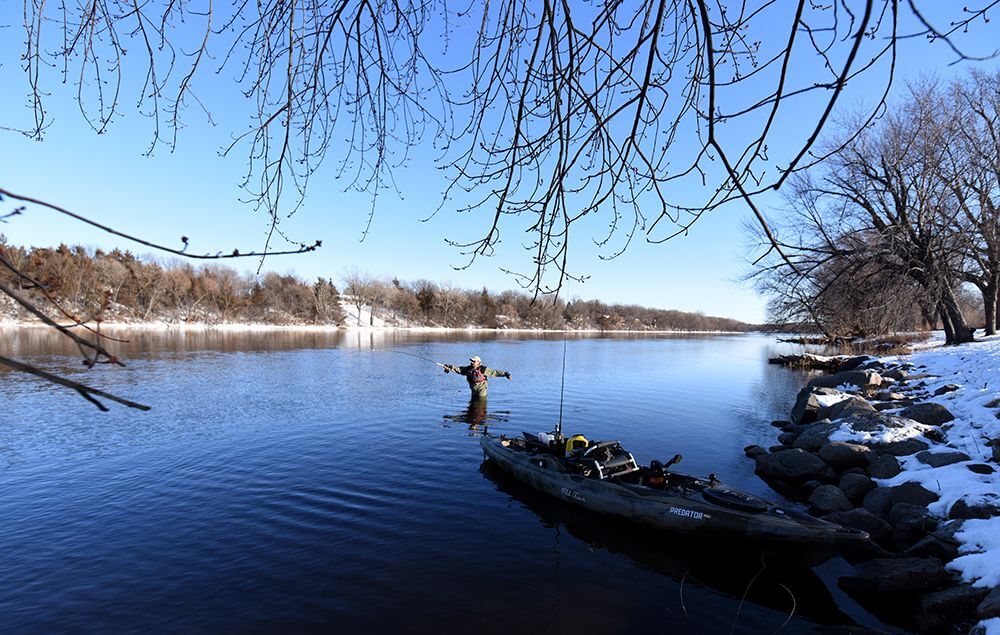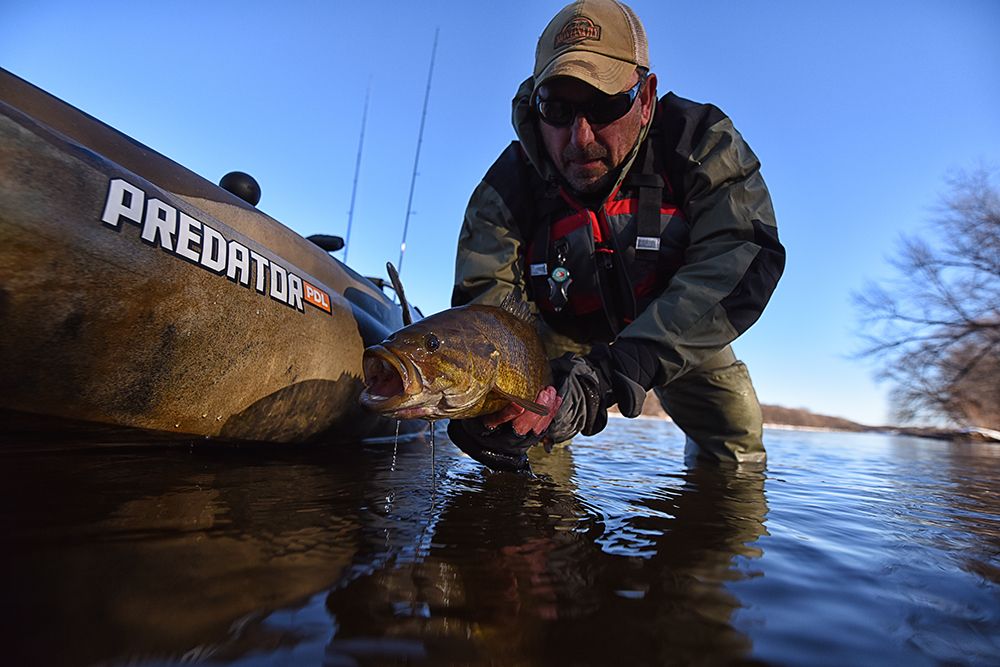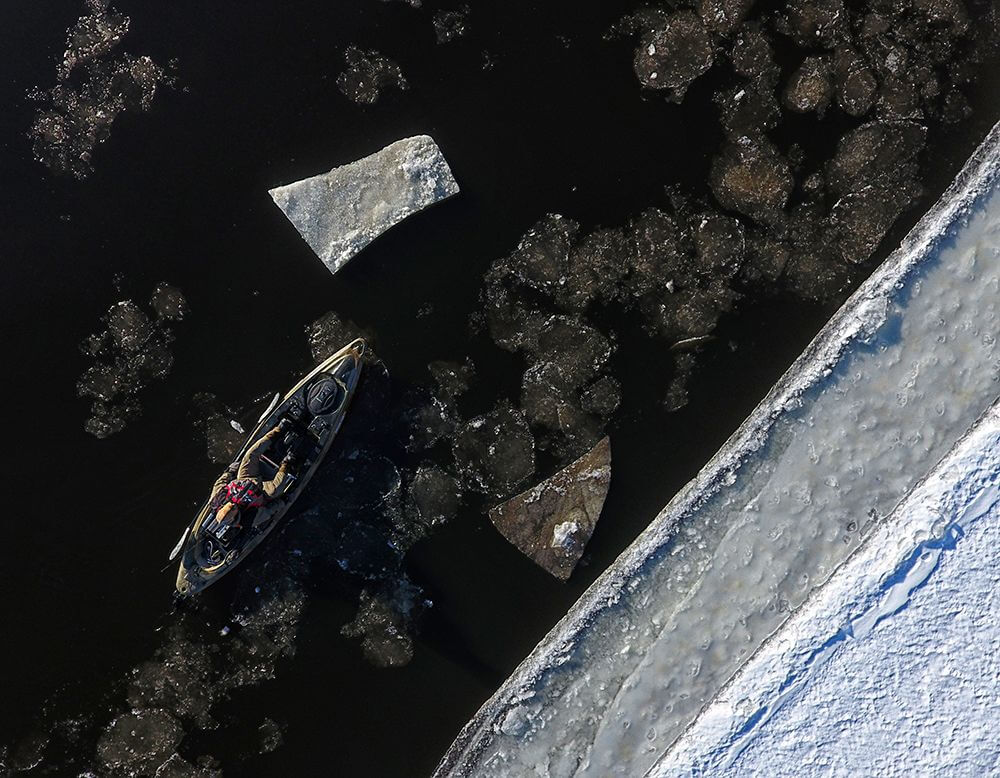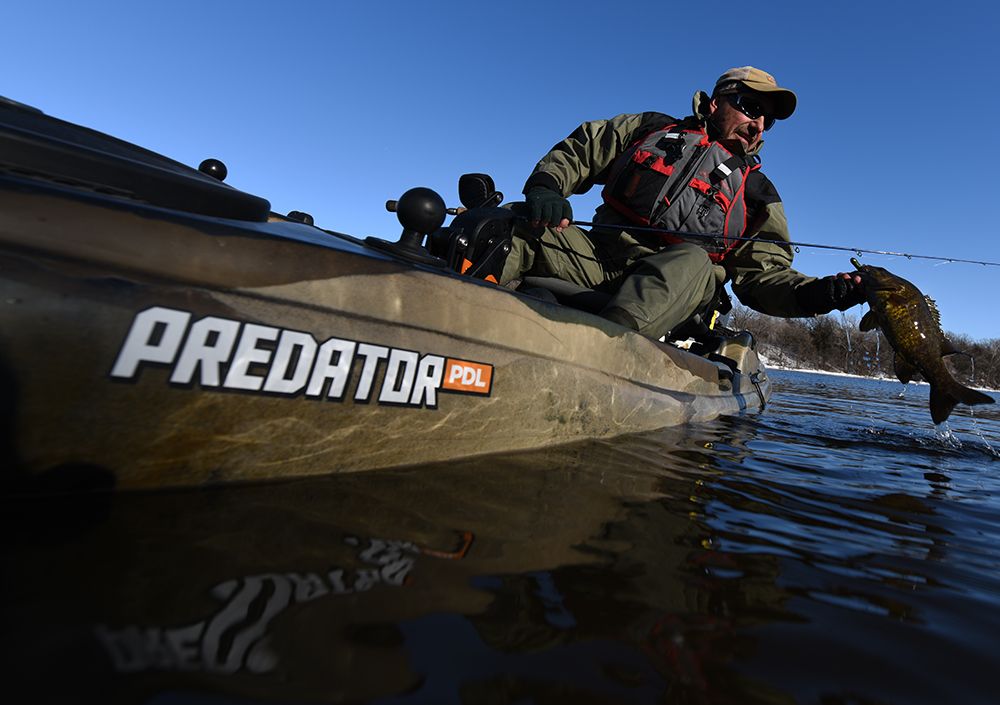Minnesota 'N' Ice: Winter Bass Fishing by Kayak
BY: JIM EDLUND
The vast majority of northern bass anglers hang up their open-water gear for the winter. With most lakes under inches (if not feet) of ice by January, most fishing involves an eight-inch hole in the ice.
“You have to look hard in the northern states, but there are places to fish bass during the winter in open water,” says Minnesota-based kayak angler Paul Hansen.
Funny thing about Hansen, he has plenty of access to open-water fish during the worst of Minnesota’s winters. As a commercial airline pilot, he’s often free to explore waters during layovers in southern climes – something he’s been doing in one form or another for almost two decades. In fact, he reluctantly admits fishing was the impetus to learn how to fly.

“After working long hours in fishing retail, I knew there had to be a better way. If I could make it through pilot’s training and build up hours and experience, I could eventually create a business to fly adventure anglers into really cool destinations, which selfishly appealed to me,” says Hansen.
Turns out Hansen took to flying as naturally as he did to fly casting, and in the year 2000, he and legendary fly angler/travel partner Trapper Rudd started an exploratory kayak fishing program.
“We put kayaks on an airplane and brought them to Mexico. We had fished all the popular destinations and set out to find untouched snook, tarpon, and bonefish by kayak. We found some epic fisheries that wouldn’t have been accessible without kayaks. This led to years of great adventures, like the stuff I read about in magazines as a kid,” says Hansen.
These days, Hansen flies fewer angling expeditions into remote locations, having opted for the stability of a commercial airline job. “My kids are involved in a lot of school activities and sports, so naturally, I want to be there for them. I don’t necessarily turn down opportunities, but let’s just say my priorities have changed.”

Still, as a competitive kayak angler who frequently competes in both the Kayak Bass Series (KBS) and Kayak Bass Fishing circuit (KBF) tournaments, there are times when Hansen gets antsy during long Minnesota winters. Having qualified for the KBS Nationals on Lake Guntersville, Alabama, this past September, Hansen says he feels the need to stay at the top of his game despite Minnesota’s harsh winter weather.
“There are warm-water effluent areas throughout the frozen north that offer an open-water alternative to ice fishing. And some of the smallmouth bass fishing is pretty phenomenal,” says Hansen.
Just minutes from his Twin Cities, Minnesota home, the warm-water discharge from power plants on the St. Croix River and Mississippi River offer some legendary winter smallmouth bass fishing opportunities.
“I ran drift boat fly fishing trips on the Mississippi River for over 20 years, so I know the water like the back of my hand. But I always felt like the drift boat had to go away at some point—and I reached that point. It was far more convenient for me to drive over, drop in the my kayak, and hit the areas that I really liked. Some spots I can fish from the kayak, other areas I get out and walk and wade.”
One particular stretch of river—the Mississippi River between St. Cloud to Elk River, Minnesota—is high on Hansen’s list for winter smallmouth. “Although I had fished this stretch for years out of my drift boat, when I started fishing it from the kayak it was like brand-new water to me. Areas I would normally bypass with the drift boat were now fishable. I could get right up onto a sand bar, into the run-outs of an island or small creek, between boulders, or right next to an island and stake out—or get out and walk and wade. It really opened up an entirely new world to me. The kayak allowed me to re-learn my water.”
Depending on the conditions, Hansen employs the use of two specific fishing kayaks, both designed and manufactured in the USA by Maine’s Old Town Canoes & Kayaks, a company with over 100 years in the watercraft business.
“I like the 12-foot Old Town Predator MX because it’s nice and short with a stable 34-inch beam. At 82 pounds, I can grab it and go—and drag it through just about anything to my access points, including deep snow. Now, if I have access to a good landing, then the Sportsman Bigwater PDL is my choice, because I then have more boat control on the river via the PDL Drive, which allows me forward and reverse with my feet and one-handed rudder control. With the MX, I’m drifting—and trying to fish on a float—and control the boat at the same time, which can be challenging on some waters. With the Predator PDL, I can back-pedal, I can slow my drift, and I can really fine tune boat control while fishing hands free.”
Despite the frigid air temperature, Hansen says he actually prefers kayak fishing smallmouth bass during the winter. “The fish tend to pod up and the kayak allows you excellent access to them. Winter is the best time to do this, more so than when they’re scattered the rest of the year.”
But Hansen admits that sometimes finding smallmouth pods can be a challenge. And even when you find them, it all comes down to just the right presentation.

WINTER SMALLMOUTH LOCATION
The first thing Hansen looks for are areas that retain heat. As cold-blooded creatures, smallmouth bass will only expend as much energy as the water temperature allows. The biological imperative is to conserve energy; when water temperatures are low, bass will move less. As water temperatures climb, bass activity increases.
“Smallies will congregate in sandy areas, which retain heat. They may pull off and feed, but their metabolism has slowed down and they’re going to spend a lot more time just hanging out, less time actively chasing. So, I’m looking for sand, a log, or a tree that has fallen into the river, all which retain heat. Same with bottom substrate. Anything that’s dark will pick up heat from the sun and attract smallmouth bass—dark rocks and boulders, even mud at times. Same thing for cover that sticks up out of the water.”
Current also plays a big part in locating winter smallmouth bass. Winter smallmouth bass are typically found adjacent to current areas, only moving into fast water to feed when absolutely necessary. More often the case, winter smallmouths relate to slack-water areas just off current seams and eddies. Anywhere that current naturally pushes food is a sure bet. Such areas are visible to the naked eye.
There are areas along the river bottom, too, where current is slower. “You can often find groups of fish in troughs—and sometimes a really small area, stacked up like cordwood. Troughs or channels offer reduced current, warmer water temperature, and provide cover. The areas behind boulders provide something similar. Again, smallmouth avoid exerting too much energy in the winter, reserving it for feeding.”
PRESENTATIONS
Left to his druthers, Hansen typically reaches for a fly rod, but has found better odds with unique, hybrid techniques that merge his experience with fly and conventional angling.
“Fly fishing works great for many situations—including winter smallmouth—but you don’t have the success rate because any time you build up slack or drag, you’re creating an unnatural presentation. This fish are going to blow it off and eat something that looks more natural. Thing is, there’s probably more food in the river at any given time during the winter than any other time of year. Very few things are physically hatching and flying away. The bottom is often littered with nymphs, leeches, and baitfish are of a size that pack a lot of calories.”
Conventional spinning tactics like a jig and minnow also introduce drag. Go too heavy in jig weight to reduce drag and you’ve got the hassle of snagging in the crevices of river rock.
“A centerpin outfit gives me the perfect drift. Due to the rod length and the entire system, the drift is longer, slower, and more precise. It allows a very natural presentation. You want split-shot placement that’s appropriate for the current and allows the minnow to float along so it slowly rolls in front of the fish and they can’t resist,” says Hansen.
To that end, Hansen uses a St. Croix Avid 13’ ML power, moderate action centerpin rod with a Raven center-pin reel loaded with 10-pound PowerPro braid. He attaches an 8 lb. Seaguar fluorocarbon leader to the main line, places small split-shots evenly below a steelhead float, and uses a small circle hook to prevent gut-hooking.
In terms of bait, Hansen’s had the best success with small-to-medium sized suckers or creek chubs. “For winter bass fishing, live bait simply produces more fish. Circle hooks make it low impact, with the hook penetrating the corner of the mouth for an easy release.”

ARTIFICIAL WAYS
There are times when Hansen goes artificial-only—like during the classic January thaw when temperatures can rise well above the 32-degree mark.
“Bass activity will definitely spike when the mercury jumps. That’s when tube jigs fished on a slow bottom crawl will keep up with live bait. It might take a few casts to get the right weight tube jig figured out so you’re not snagging or drifting, but once you do, they’re easy to fish. Wacky worms like Z-Man Zinkerz work in winter, too. Same for Fluke-style baits. Even hardbaits like the LiveTarget Emerald Shiner Baitball jerkbait, twitched with super-long pauses. Just remember to work any baits slower than you would other times of the year.”
For situations like this, Hansen leaves the centerpin rig in the rod holder, and throws baits on a versatile 7’1” medium-power, fast-action St. Croix Legend Bass Tournament spinning rod and Daiwa spinning reel spooled with 8- to 10-pound Seaguar InvisX fluorocarbon.

WINTER BASS SAFETY
Any time you’re fishing in winter—whether on the ice or open water—safety should be your first priority. Navigating rivers in winter can be dangerous. Ice floes are not uncommon, even in areas with warm-water effluent. Should an impact with an ice floe knock you out of your kayak, a PFD and spare clothes can save you from drowning and hypothermia.
“Because it’s one dump and game over, I always wear a PFD, and keep a dry bag filled with another pair of long underwear, socks, a top, another jacket, hat, gloves, etc. in my Old Town Predator’s bow hatch. I wear Gore-Tex waders, wading boots, a base layer, and fleece pants underneath. The big thing is staying warm and comfortable without too much clothing. You don’t want excessive sweating; neither do you want so much bulk that entering the kayak becomes difficult. I also keep my cell phone in a dry bag, and waterproof matches to start a fire on shore if need be to warm up and change clothing. I’ve yet for something like this to happen. Honestly, part of that is my choice in kayak. You wouldn’t want to fish rivers in winter with a Wal-Mart special. Old Town Predators are incredibly stable kayaks designed to resist tipping and allow anglers to even stand up and fish.”
END NOTE
Stuck with cabin fever or mid-season ice fishing burnout? In need of an open-water bass adventure? Hansen encourages anglers to investigate local rivers. Find warm-water discharge from a power plant, water treatment facility, or other industry, and you’re in business. Employ a kayak to get beyond the bank, learn to execute a perfect drift, experiment with live and artificial baits, and you might just be amazed by the hot bass bites possible in the dead of winter.
